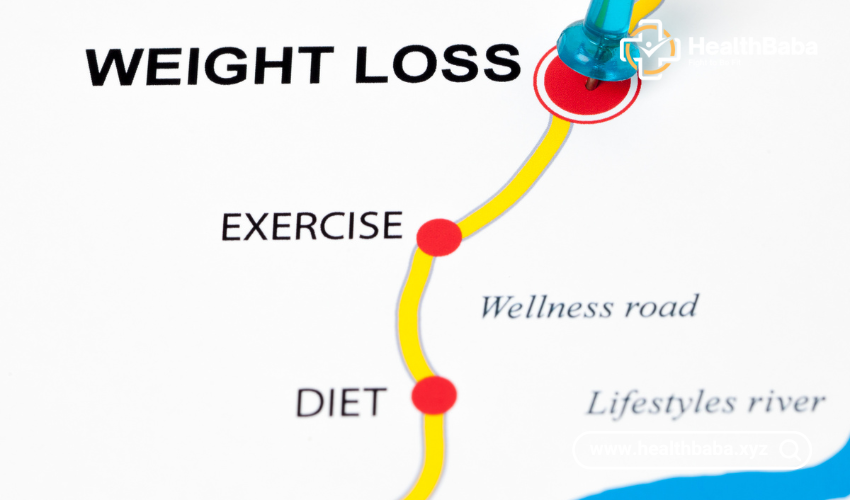The Simple Fat Loss Plan is a weight-loss program that focuses on changing daily habits to promote weight loss. By incorporating simple habits such as eating more fruits and vegetables, this plan aims to help individuals shed fat and maintain a healthy lifestyle.
It is an effective and sustainable approach to weight loss that emphasizes healthy eating and fueling workouts. In addition, the plan provides a variety of meal options that are easy to follow. Whether you are a beginner or looking for a simple meal plan to lose weight, this program offers a straightforward and practical solution.
Understanding The Basics Of Fat Loss
H3the Science Behind Fat Loss/h3
To effectively lose fat, it’s important to understand the science behind fat loss. Fat loss occurs when your body burns more calories than it consumes. This creates an energy deficit, causing your body to tap into its fat stores for fuel. By consistently maintaining this energy deficit, you can achieve long-term fat loss.
H3how The Body Burns Calories/h3
Your body burns calories through a process called metabolism. Metabolism is the sum of all the chemical reactions that occur in your body to maintain life. When it comes to fat loss, there are two primary ways your body burns calories:
- Resting metabolic rate (RMR): This is the number of calories your body needs to maintain basic bodily functions at rest, such as breathing, circulating blood, and controlling body temperature. RMR accounts for the majority of the calories you burn each day.
- Physical activity: This includes all forms of movement, from structured exercise to everyday activities like walking, cleaning, or playing sports. Physical activity increases calorie expenditure and can contribute significantly to fat loss.
H3key Factors For Successful Fat Loss/h3
When it comes to successfully losing fat, several key factors can make a significant difference. These factors include:
- Caloric deficit: To achieve fat loss, you must consume fewer calories than you burn. This can be done through a combination of reducing calorie intake and increasing physical activity levels.
- Nutrition: Eating a balanced, nutrient-dense diet is crucial for fat loss. Focus on consuming plenty of fruits, vegetables, lean proteins, whole grains, and healthy fats while limiting processed foods, sugary beverages, and excessive amounts of added sugars and unhealthy fats.
- Exercise: Regular exercise helps increase calorie expenditure, preserve lean muscle mass, and improve overall fitness. Aim for a mix of cardiovascular exercise, strength training, and flexibility exercises to maximize fat loss and overall health.
- Consistency: Consistency is key when it comes to fat loss. Making sustainable lifestyle changes and sticking to them over time is essential for long-term success. Set realistic goals, establish healthy habits, and stay consistent in your efforts.
- Stress management and sleep: Chronic stress and inadequate sleep can negatively impact fat loss efforts. Prioritize stress management techniques, such as meditation or yoga, and aim for 7-9 hours of quality sleep each night to optimize fat loss and overall well-being.
Creating A Sustainable Fat Loss Meal Plan
When it comes to achieving fat loss goals, a key component is creating a sustainable meal plan. A sustainable meal plan not only helps you shed those extra pounds but also ensures that you maintain a healthy lifestyle in the long run. In this section, we will explore the essential steps to creating a sustainable fat loss meal plan that will keep you on track to achieve your goals.
Planning Your Meals For Success
One of the first steps in creating a sustainable fat loss meal plan is to plan your meals strategically. This involves identifying your calorie needs and allocating them wisely throughout the day. To do this effectively, consider the following:
- Determine your daily caloric intake based on your weight loss goals.
- Divide your calories into balanced meals and snacks spread throughout the day.
- Ensure that each meal includes a good balance of macronutrients, such as proteins, carbohydrates, and healthy fats.
Incorporating Nutrient-dense Foods
Another important aspect of a sustainable fat loss meal plan is incorporating nutrient-dense foods. These foods are rich in essential nutrients while being low in calories, making them ideal for weight loss. Consider the following tips when selecting nutrient-dense foods:
- Include plenty of fruits and vegetables in your meals to add essential vitamins, minerals, and fiber.
- Incorporate lean protein sources like chicken, fish, tofu, or legumes to support muscle growth and repair.
- Choose whole grains, such as quinoa, brown rice, and whole wheat bread, for sustained energy and fiber content.
- Opt for healthy fats from sources like avocado, nuts, and olive oil, which provide essential fatty acids for overall health.
Meal Prepping For Fat Loss
Meal prepping is a practical strategy for individuals trying to lose fat and maintain a healthy lifestyle. By preparing your meals in advance, you eliminate the temptation to make unhealthy choices when you’re pressed for time. Here are some basic meal prepping tips to help you stay on track:
| Meal Prepping Tips |
|---|
| Choose one or two days of the week to batch cook your meals. |
| Invest in quality food containers to store your prepped meals. |
| Portion out your meals into appropriate serving sizes to prevent overeating. |
| Include a variety of proteins, vegetables, and whole grains in your prepped meals to promote balanced nutrition. |
By following these guidelines for meal planning, incorporating nutrient-dense foods, and meal prepping, you can create a sustainable fat loss meal plan that supports your weight loss journey while ensuring you maintain a healthy lifestyle. Remember, consistency and smart choices are the keys to achieving long-term success.
The Simple Fat Loss Workout Routine
When it comes to losing fat and achieving your weight loss goals, a properly designed workout plan is key. The Simple Fat Loss Workout Routine focuses on incorporating exercises that maximize calorie burn and target fat loss. To design an effective fat-burning workout plan, consider the following:
- Set Clear Goals: Define your specific fat loss goals, whether it is shedding pounds, toning your body, or improving overall fitness.
- Assess Your Fitness Level: Evaluate your current fitness level to determine what exercises and intensity levels are appropriate for you.
- Choose the Right Exercises: Incorporate a mix of cardiovascular exercises and strength training to maximize fat loss and muscle tone.
- Create a Schedule: Determine the frequency and duration of your workouts, making sure to allow for rest and recovery days.
- Progressive Overload: Gradually increase the intensity and difficulty of your workouts to challenge your body and promote continuous fat loss.
To optimize fat burning and achieve lean muscle definition, combining both cardio and strength training exercises is essential.
When it comes to cardio exercises, activities like running, cycling, swimming, and HIIT workouts are effective in boosting heart rate and burning calories. Aim for at least 150 minutes of moderate-intensity cardio or 75 minutes of vigorous-intensity cardio per week.
Strength training exercises such as weightlifting, bodyweight exercises, and resistance band workouts help build lean muscle mass. Incorporate strength training into your routine at least two days a week, targeting major muscle groups.
By combining these two types of exercises, you’ll not only burn fat during your workouts but also increase your metabolic rate, resulting in continued fat burning even at rest.
Staying motivated and consistent with your fat loss workout routine is crucial for long-term success. Here are a few tips to help you stay on track:
- Set Realistic Goals: Set achievable goals that are realistic and sustainable, avoid setting unrealistic expectations.
- Find an Accountability Partner: Partner up with a friend or join fitness communities to keep each other motivated and accountable.
- Vary Your Workouts: Keep your workouts interesting and fun by trying new exercises, classes, or outdoor activities.
- Reward Yourself: Celebrate milestones and achievements with non-food rewards to maintain motivation and reinforce positive behavior.
- Track Your Progress: Keep a record of your workouts, measurements, and how you feel to visually see your progress over time.
- Listen to Your Body: Pay attention to your body’s signals and adjust your workout intensity, duration, or rest days accordingly.
By incorporating these tips into your fat loss workout routine, you’ll be more likely to stay motivated and consistent, ultimately leading to the successful achievement of your weight loss goals.
Developing Healthy Habits For Long-term Success
Developing healthy habits is crucial for long-term success in the simple fat loss plan. By incorporating simple habits like eating more fruits and vegetables, individuals can achieve sustainable weight loss and maintain a healthy lifestyle. Say goodbye to fad diets and focus on fueling workouts and prioritizing healthy eating for effective fat burning and weight loss.
Mindset Shifts For Sustainable Fat Loss
When it comes to long-term fat loss success, developing a healthy mindset is crucial. Instead of viewing weight loss as a temporary fix, it’s important to shift your perspective to a lifestyle change. Adopting a positive mindset can help you stay motivated and committed to your goals.
Here are some mindset shifts you can make for sustainable fat loss:
- Focus on progress, not perfection. Understand that losing weight takes time and effort. Celebrate small victories along the way and remember that every little step counts.
- Embrace the journey. Instead of being solely focused on the end result, enjoy the process of becoming healthier. Find pleasure in nourishing your body with nutritious foods and engaging in physical activity.
- Practice self-compassion. Be kind to yourself and avoid negative self-talk. Remember that setbacks and slip-ups are a normal part of the journey. Instead of beating yourself up, learn from them and move forward.
- Set realistic goals. Avoid setting unrealistic expectations that may lead to frustration and disappointment. Set achievable goals that are specific, measurable, attainable, relevant, and time-bound (SMART).
Strategies For Overcoming Cravings And Emotional Eating
Cravings and emotional eating can often derail your fat loss progress. However, there are strategies you can implement to overcome these challenges:
- Identify triggers. Pay attention to what triggers your cravings and emotional eating. Is it stress, boredom, or certain food cues? Once you identify the triggers, you can develop strategies to avoid or cope with them.
- Find healthier alternatives. Instead of giving in to unhealthy cravings, find healthier alternatives that satisfy your taste buds. For example, swap sugary snacks for fresh fruits or opt for air-popped popcorn instead of chips.
- Practice mindful eating. Slow down and pay attention to your food. Chew slowly and savor each bite. This can help you become more aware of your hunger and fullness cues, preventing overeating.
- Seek emotional support. Emotional eating is often related to emotional well-being. Find healthy ways to cope with emotions, such as talking to a supportive friend or practicing relaxation techniques.
Building A Supportive Environment
A supportive environment can greatly influence your fat loss journey. Surrounding yourself with positive influences and creating a conducive environment can increase your chances of success. Here are some tips:
- Stock your pantry with healthy options. Fill your kitchen with nutritious foods that align with your fat loss goals. Remove temptations that may lead to mindless snacking.
- Find an accountability partner. Having someone who shares your fat loss goals can provide motivation and support. You can work together, share progress, and hold each other accountable.
- Join a fitness community. Engaging in group exercise classes or joining fitness clubs can provide social support and make your journey more enjoyable. Surrounding yourself with like-minded individuals can keep you motivated and inspired.
- Seek professional guidance. Consulting a registered dietitian or a certified trainer can provide you with expert advice tailored to your individual needs. They can guide you through the process and offer support.
Tracking Progress And Adjusting The Fat Loss Plan
Tracking your progress is an essential part of any fat loss plan. It allows you to see how your efforts are paying off and make adjustments accordingly. Evaluating and adjusting your meal plans and workouts can help optimize your results and ensure continued progress. Additionally, celebrating milestones along the way and maintaining your achieved results is key to long-term success. In this section, we will explore various ways to track progress, evaluate and adjust your fat loss plan, and maintain your hard-earned results.
Monitoring Weight Loss Progress
One of the simplest and most effective ways to track your progress is by monitoring your weight loss. Keep a record of your weekly weigh-ins to see how your weight is changing over time. It’s important to remember that weight fluctuates naturally, so don’t get discouraged by small variations. Instead, focus on the overall downward trend.
Consider using a weight tracking app or creating a table to record your progress visually. This can help you see patterns and stay motivated. Don’t solely rely on the scale, though. Take measurements of your waist, hips, and other areas of interest. Sometimes, your body composition changes even if the scale doesn’t budge. Tracking these measurements will give you a more comprehensive view of your progress.
Evaluating And Adjusting Meal Plans And Workouts
Your meal plans and workouts play a crucial role in your fat loss journey. They provide the fuel and stimulus needed to shed those extra pounds. However, it’s essential to evaluate and adjust them regularly to avoid plateaus and maximize your results.
Start by assessing your current meal plan. Analyze your macronutrient intake, portion sizes, and overall calorie consumption. Consider consulting a nutritionist or using online tools to determine the ideal calorie deficit for your goals. Based on this information, make necessary adjustments to your meal plan to maintain a sustainable and healthy weight loss pace.
Similarly, review your workout routine to ensure you’re challenging yourself adequately. If you find that you’re not seeing progress, it might be time to increase the intensity or switch up your exercises. Incorporate a mix of cardiovascular exercises, strength training, and flexibility exercises to achieve a well-rounded fat loss regimen. Remember, variety is key!
Celebrating Milestones And Maintaining Results
As you progress in your fat loss plan, it’s important to celebrate milestones along the way. Whether it’s reaching a specific weight loss goal or fitting into a smaller clothing size, acknowledging your achievements will keep you motivated and focused. Reward yourself with non-food-related treats such as a spa day, new workout gear, or a day off to relax and recharge.
Maintaining the results you’ve achieved is just as important as the journey itself. Once you’ve reached your weight loss goal, transition into a maintenance phase where you continue to practice healthy habits and sustain your new lifestyle. This includes continuing to monitor your weight, sticking to a balanced meal plan, and staying consistent with your workouts.
In conclusion, tracking progress, evaluating and adjusting meal plans and workouts, and celebrating milestones are crucial components of any effective fat loss plan. Remember that everyone’s journey is unique, so listen to your body and make changes that align with your goals. Stay committed, stay positive, and keep working towards a healthier, happier you!
Frequently Asked Questions For The Simple Fat Loss Plan
What Is The Simplest Way To Lose Fat?
The simplest way to lose fat is by following a weight-loss program that focuses on healthy habits. This includes adding more fruits and vegetables to your diet and breaking bad eating habits. Fad diets don’t work, so it’s important to prioritize healthy eating and fuel your body for workouts.
A simple meal plan can help you achieve your goals.
How Can I Lose 20 Pounds In A Month?
To lose 20 pounds in a month, follow these guidelines: – Focus on changing your daily habits, such as adding more fruits and vegetables to your diet. – Avoid fad diets and prioritize healthy eating. – Create a meal plan that includes nutritious dishes.
– Prioritize workouts and fuel your body properly. – Seek professional advice for a weight loss program that suits your needs.
How Long Will It Take To Lose 30 Pounds On A 1200 Calorie Diet?
Losing 30 pounds on a 1200 calorie diet can take several months. It depends on factors like your metabolism and activity level. Stick to the plan and consult a healthcare professional for personalized advice.
How Many Pounds Will I Lose If I Eat 1200 Calories A Day?
By consuming 1200 calories a day, you can expect to lose weight, but the amount varies depending on factors such as metabolism, activity level, and starting weight. Consult with a healthcare professional for personalized guidance on your weight loss journey.
Conclusion
Incorporating simple habits into your daily routine can be the key to successful fat loss. By focusing on adding more fruits and vegetables to your meals, you can fuel your workouts and prioritize healthy eating. Avoid falling for fad diet plans and opt for a sustainable weight-loss program that keeps you energized and nourished.
Remember, our bodies are designed to burn calories, so make the most of it with a simple and effective meal plan. Stay committed and watch the pounds melt away!
















Add Comment